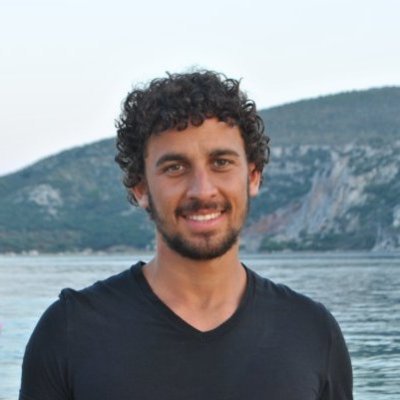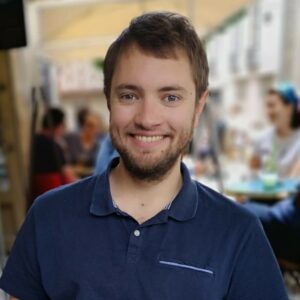
Fabrizio Schiano
|

Fabrizio Schiano
|

Email : florian.berton@inria.fr
Address :
IRISA, INRIA Rennes – Bretagne Atlantique
Campus Universitaire de Beaulieu
35042 Rennes, France
Assistant : 02 99 84 22 52 (Hélène de La Ruée)
In September 2016, I graduated from ENSIMAG engineering school, with a specialty in computer vision and 3D graphic. I also graduated in December 2016 from Ecole Polytechnique Montréal, with a Research-Based Master degree in the Biomedical Engineering Department. The project of this master was an automatic analyze of vertebrae ultrasound images. During this project, I developed software for simulated vertebrae ultrasound images and I implemented a method for automatically segmented the vertebrae in ultrasound images.
Then I joined A2iA, which is a company working on both printed and handwritten text recognition using computer vision, machine learning and deep learning.
I am currently a PhD student at Inria Rennes – Bretagne Atlantique, in the Rainbow team, under the supervision of Julien Pettré. The subject of my thesis is “Design of a virtual reality platform for studying immersion and behaviours in aggressive crowds” in the context of the project OPMOPS.

fabien.grzeskowiak@insa-rennes.fr
En 2016 j’ai été diplômé de l’école d’ingénieurs ENSMM avec une spécialisation en mécatronique et automatisme. J’ai été diplômé en 2016 de l’université UFC avec une spécialisation en mécatronique micro-systèmes et électronique embarquée. J’ai travaillé pendant 6 mois pour mon mémoire de master au sein de Moving Magnet Technologies un laboratoire français spécialisé dans la conception de capteurs et actionneurs électro-magnétiques. Le but du projet était de concevoir un système et une loi de commande pour un actionneur rapide puissant avec des non linéarités en termes de force/position courant/Inductance. Avant cela j’ai fait un stage de 6 mois chez Bombardier Transport France en tant qu’ingénieur junior en conception mécanique.
Entre mon stage de maîtrise et le début de mon doctorat j’ai travaillé pendant 1 an dans une entreprise privée Partnering Robotics où j’étais en charge du package firmware de la conception à l’intégration. J’étais également en charge de la veille technologique et de l’intégration de nouveaux capteurs et actionneurs de télémétrie.
J’ai soutenu ma thèse de doctorat en 2021 dans l’équipe RAINBOW de l’INRIA sous la direction de Julien Pettré. Les travaux de ma thèse s’inscrivent dans le cadre du projet CrowdBot dont l’objectif était de concevoir des techniques de navigation pour les robots en environnement de foule. Plus précisément mon travail est principalement axé sur la conception d’un environnement physique entièrement simulé qui simule une foule et un robot afin d’évaluer les techniques de navigation.
Je suis aujourd’hui chercheur post-doctoral à l’INSA de Rennes au sein de la chaire IH2A portée par Marie Babel. Mes travaux de recherche sont orientés autour de la robotique d’assistance aux personnes et de l’assistance à la mobilité.
Mes travaux s’effectuent dans le cadre du projet européen ADAPT visant au développement de fauteuil roulant electrique intelligent ainsi qu’au développement de simulateurs de conduite de fauteuil multisensoriels en réalité virtuelle.
Je suis également impliqué dans le projet défi Inria DORNELL visant à l’élaboration d’une poignée haptique innovante, multisensorielle, multimodale et intelligente qui peut être facilement installée sur les aides à la mobilité.
Email : axel.lopez-gandia@irisa.fr
Address :
IRISA, INRIA Rennes – Bretagne Atlantique
Campus Universitaire de Beaulieu
35042 Rennes, France
Tel : 02 99 84 XX XX
Fax : 02 99 84 71 71
Assistant : 02 99 84 22 52 (Hélène de La Ruée)
In July 2014, I graduated with a Bachelor’s degree in Physics from Universitat de Barcelona (UB).
In July 2016, I graduated with a Master’s degree in Innovation and Research in Informatics from Universitat Politècnica de Catalunya (UPC) with the specialization in Computer Graphics and Virtual Reality. During my master’s degree, I completed three internships in UPC with various objectives, development of an automated scheduling tool, development of architectural visualization tools for virtual reality and development of optic simulator software.
In October 2016, I joined the Rainbow team (former Lagadic team) as PhD student. I work under the supervision of Julien Pettré and François Chaumette in steering models for character animation based on synthetic vision and optical flow.
Email : quentin.delamare @ irisa/inria.fr
Address :
IRISA, INRIA Rennes – Bretagne Atlantique
Campus Universitaire de Beaulieu
35042 Rennes, France
Assistant : 02 99 84 22 52 (Hélène de La Ruée)
From 2012 to 2016 I studied Mechatronics at ENS Rennes, graduating Mechanics and Electronics degrees. In 2015 I obtained the french “Agrégation” opening for teaching positions, in electronics engineering.
I did my Ph.D from 2016 to 2019 under the supervision of Dr. Paolo Robuffo Giordano and Dr. Antonio Franchi, on the thematic of aerial robotics with physical interaction and trajectory generation with parametric uncertainty considerations.
Currently I am part of the Rainbow team (ex-Lagadic) as “agrégé préparateur” (APGR) of ENS Rennes.
I teach at ENS Rennes in mechatronics-related fields such as control and planning of robots, reverse engineering, processors, networks, and in the preparation for the oral of agrégation in the electronics and computing options.
My research is in the field of Aerial Physical Interaction, which mainly assembles dynamics modeling, control, planning/optimization, uncertainties, and design.
Email : aline.baudry @ irisa.fr
Address :
IRISA, INRIA Rennes – Bretagne Atlantique
Campus Universitaire de Beaulieu
35042 Rennes, France
Assistant : 02 99 84 22 52 (Hélène de La Ruée)
I graduated with a Mechanical and Control Systems Engineering degree from the INSA Rennes in September 2016.*
For the last semester of my master degree, I choose to specialize in control and embedded systems. I decided to study at the Department of Mechanical Engineering of the Technical University of Munich (TUM) during the winter semester 2015/2016.
Then, I worked at the Gipsa-lab in Grenoble for 6 months on my master’s thesis, which the subject was “Put this there ! : Modeling deictic gestures for a humanoid robot”.
I am actually a PhD student in the Rainbow (previously Lagadic) group at IRISA / INRIA in Rennes under the supervision of Dr. Marie Babel (INSA/IRISA) and Sylvain Guégan (INSA/LGCGM). My research objective is to model the dynamics of the electric powered wheelchair. This model will allow to improve the driving assistance control laws during the semi-autonomous navigation. It also will be used in the development of a wheelchair driving simulator.
Email : hadrien.gurnel @ irisa.fr
Address :
IRISA, INRIA Rennes – Bretagne Atlantique
Campus Universitaire de Beaulieu
35042 Rennes, France
Assistant : 02 99 84 22 52 (Hélène de La Ruée)
From 2012 to 2015, I studied Electronics at ENSEIRB-MATMECA (an engineering school located in Bordeaux, France) with a major in Image and Signal Processing. I conducted my 6-month graduation internship at Technicolor R&D (Cesson-Sévigné), under the supervision of Franck Galpin, on the topic of HDR video compression. Then, I enrolled in a 10-month training at EON Reality (Laval, France), during which I studied Virtual and Augmented Reality. Since October 2016, I am a PhD student at IRT b<>com and Irisa Rennes – Bretagne Atlantique, in the Rainbow team , under the supervision of Alexandre Krupa (Inria), Maud Marchal (Irisa) and Laurent Launay (IRT b<>com). My research focuses on Medical Imaging and Robotics.
Email : pedro-alfonso.patlan-rosales@inria.fr
Address :
IRISA, INRIA Rennes – Bretagne Atlantique
Campus Universitaire de Beaulieu
35042 Rennes, France
Tel : 02 99 84 74 50
Fax : 02 99 84 71 71
Assistant : 02 99 84 22 52 (Hélène de La Ruée)
I obtained my Bachelor in Mechatronics Engineering at University of Guanajuato, Mexico in 2010 where I worked on “Object Localization by a camera to control a robotic arm”. After, I received my Master degree in Electrical Engineering at University of Guanajuato, Mexico in 2012 where I worked on “Visual odometry and 3D reconstruction”. During my Master degree I did an internship at INRIA Sophia Antipolis with EVOLUTION team from May to November 2011 with a project named “Development of a Vision-based Robot Control Application”.
I carried out my Ph.D. in the LAGADIC team at IRISA/INRIA-Rennes (now Rainbow team). During my Ph.D. I was working in the field of Medical Robotics, and the title of my thesis is “A robotic control framework for quantitative ultrasound elastography” under the supervision of Dr. Alexandre Krupa. Elastography is a promising technique that unveils the elastic parameters of a tissue. This feature is being exploited in medical diagnosis of diseases (e.g., liver fibrosis, breast cancer). In addition, elastography is a non-invasive technique which improves the comfort of a patient. In my Ph.D. thesis we developed three novel robotic approaches to assist examiners with elastography. The first approach deals with the control of a robot actuating an ultrasound probe to perform palpation motion required for ultrasound elastography. The elasticity of the tissue is used to design a servo control law to keep a stiff tissue of interest in the field of view of the ultrasound probe. Additionally, the orientation of the probe is controlled by a human user to explore other tissue while elastography is performed. The second approach exploits deformable image registration of ultrasound images to estimate the tissue elasticity and to help in the automatic compensation by ultrasound visual servoing of a motion introduced into the tissue. The third approach offers a methodology to render the tissue elasticity by moving a virtual probe in the ultrasound image with a haptic device while the robot is performing palpation motion. Experimental results of the three robotic approaches over phantoms with tissue-like offer an excellent perspective for robotic-assistance for ultrasound elastography.
A list of my publications can be found here.